Many BPA-free bottles contain a chemical that causes arrhythmia, hyperactivity and brain changes
by: David Gutierrez
BPA, BPS, plastics chemicals
(DrEddyClinic News) A chemical found in many products labeled "BPA free" may produce many of the same health problems as the original chemical, including hyperactivity and cardiac arrhythmia, according to a pair of studies presented recently at the joint meeting of the International Society of Endocrinology and the Endocrine Society in Chicago.
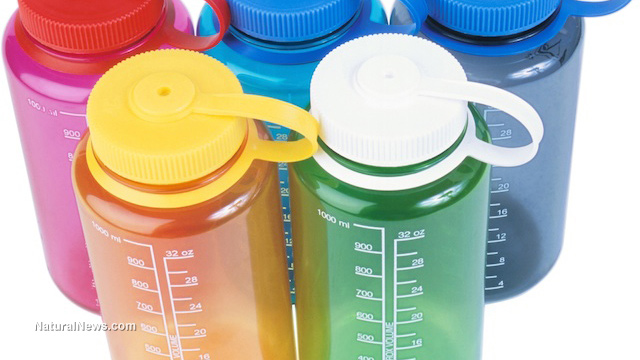
"BPS, termed the safe alternative to BPA, may be equally as harmful to developing brains," said Deborah Kurrasch of the University of Calgary, lead researcher of one of the studies. "Society must place increased pressure on decision makers to remove all bisphenol compounds from manufacturing processes."
The "Safer" alternative is not so safe
Bisphenol A, or BPA, is a widely used chemical that is a known hormone disrupter and has been linked to health conditions as diverse as cancer, obesity, hyperactivity and reproductive problems.
Growing concern over the health effects of BPA has led many manufacturers to introduce "BPA free" products. Yet many -- although not all -- of these products rely on a closely related chemical, bisphenol S (BPS).
"BPS is one of the substitutes used in BPA-free products," said Hong-Sheng Wang of the University of Cincinnati, lead researcher of the second study. "There is implied safety in BPA-free products. The thing is, the BPA analogs -- and BPS is one of them -- have not been tested for safety in humans."
BPS disrupts multiple hormone pathways
In the first study, Kurrasch and her colleagues found that zebrafish that were exposed to BPS became hyperactive in a similar manner to those exposed to BPA http://dreddyclinic.com/forum/viewtopic.php?f=11&t=32616.
The study was designed to simulate prenatal chemical exposure, such as would occur in pregnant women exposed to BPA or BPS. Researchers exposed zebrafish embryos to the same BPA http://dreddyclinic.com/forum/viewtopic.php?f=32&t=32615 concentrations found in Alberta's Oldman River, a major drinking water source. They then counted how many neurons developed in the brain.
The researchers found that fish exposed to BPA had 170% more neurons at the time of peak neuronal birth than fish not exposed to any chemicals. Fish exposed to equivalent concentrations of BPS http://dreddyclinic.com/forum/viewtopic.php?f=116&t=33770 had 240% more. In addition, both BPA- and BPS-exposed fish demonstrated hyperactive behavior (as determined by movement tracking software) in a way that fish in non-exposed control groups did not.
The second study, which Wang called, "one of the first assessments of BPS' effect in mammalian primary cells or organs," found that BPS produced arrhythmia http://dreddyclinic.com/findinformation/hh/heartarrhythmias.php -- abnormalities in heart rhythm -- in a similar manner to BPA.
Researchers exposed approximately 50 rats to a 1-nanomolar dose of BPS, roughly equivalent to the concentrations that prior studies have found in human urine. The rats' hearts were stimulated with the hormone catecholamine to mimic a natural stress response, and then BPS was sent flowing through the arteries and into the pumping heart. A control group of 30 rats was treated with catecholamine, but not with BPS.
The researchers found that the hearts of the female rats (but not the male rats) exposed to BPS exhibited a rapid heartbeat (ventricular tachycardia) and extra heartbeats. This problem seemed to occur because BPS caused abnormal calcium cycling in a manner similar to that caused by BPA.
When the researchers blocked the estrogen receptors in the female rats, the BPS-induced arrhythmia eased, confirming an estrogen-mimicking role for BPS, much like BPA.
Notably, the Calgary researchers found that BPA, and perhaps also BPS, might disrupt hormones through pathways other than by mimicking estrogen. In the zebrafish study, BPA actually appeared to mimic testosterone http://bit.ly/testosterone-support, a predominantly male sex hormone http://www.dreddyclinic.com/forum/viewtopic.php?f=31&t=33259.
Wang's summary of the Cincinnati research could easily apply to both studies: "Our findings call into question the safety of BPA-free products containing BPS," he said. "BPS and other BPA analogs need to be evaluated before further use by humans."
Sources for this article include:
http://www.newswise.com/
http://www.newswise.com/articles/common-bpa-like-chemical-bps-disrupts-heart-rhythms-in-females
Too little magnesium in your diet could have drastic effects
by: Sarah Landers
magnesium, deficiency, warning signs
(DrEddyClinic News) Magnesium is an important mineral to include in your diet – and yet it's not something you hear about on a regular basis. You are probably aware of the importance of calcium or iron for your health, however you might not realize that adequate magnesium levels are crucial for brain, cardiac and muscle function, as reported recently by DrEddyClinic News.

According to Ancient Minerals, magnesium is vital http://www.dreddyclinic.com/forum/viewtopic.php?f=21&t=33111; without it we would not produce energy, our muscles would be in a permanent state of contraction, and we could not adjust the levels of cholesterol produced and released into the blood. Magnesium is also needed, along with silica and Vitamins D and K, to promote bone health.
According to Life Extension, a shocking 68 percent of Americans do not consume the recommended minimum daily requirement of magnesium. And a staggering 19 percent do not even consume half of the government's recommended daily intake.
[Note from Adams: I just completed ICP-MS testing of the nutritive minerals for 15 of the top-selling protein powders and superfood supplements. I found that Living Fuel Ultimate Super Berry and Super Greens products contained 400% higher magnesium than the average of all the other brands. I'll be publishing these results in a future science journal issue, but for now, Living Fuel superfoods are laboratory proven to be a very high source of magnesium, zinc and other nutritive minerals.]
The warning signs that you aren't getting enough
Ringing in your ears or hearing loss
Otherwise known as tinnitus, a constant, high-pitched ringing in your ears is a common symptom of magnesium deficiency, as reported by Natural News. According to various studies that examined the relationship between ear health and sufficient magnesium http://dreddyclinic.com/forum/viewtopic.php?f=19&t=34425 levels, it has been found that sufficient quantities of magnesium will actually prevent the formation of free radicals that can lead to hearing loss.
Muscle cramps or tremors
Your muscles function because of magnesium; without it, your body would be in a state of convulsion and your muscles would be unable to relax. Lack of sufficient magnesium can cause facial tics, muscle cramping and twitching of the feet while trying to sleep.
Depression
There is a long established link between low levels of magnesium and depression http://www.psychiatry.news/, and for over a century, doctors have used it to treat mental health disorders. A recent study in a psychiatric hospital in Croatia found that many attempted suicide patients had severely low levels of this crucial mineral. Of course, the benefit of treating depression with magnesium is that it doesn't have the side effects http://www.sideeffects.news/ associated with chemical medications.
Abnormal heart function
Because of magnesium's effect on muscles, low levels of this mineral can affect your heart and induce a condition known as cardiac arrhythmia. This is when your heart does not beat regularly, and the condition can cause other complications, such as heart attack and stroke.
Kidney stones
While some scientists say that kidney stones are the result of too much calcium, others believe that it is a lack of magnesium that is the main culprit. Magnesium prevents the formation of kidney stones by preventing calcium from binding with oxalate.
Foods that are high in magnesium
By incorporating the following foods into your diet, you can help to make sure that you do not become deficient in this vital mineral:
Fruit and vegetables
According to News Max, fruits such as bananas, oranges, cherries, pineapples and avocados are rich sources of magnesium and have many other health benefits.
Fish
Mackerel and shrimp are particularly high in magnesium; 100g of mackerel provides approximately 95 milligrams of magnesium.
Dairy
Milk, butter, cheese and yogurt are rich sources of magnesium, with 100g of yogurt providing 20 milligrams of magnesium.
Chocolate
If you're a lover of chocolate, you'll be pleased to learn that it is high in magnesium and aids good mood. 100g of dark chocolate provides a whopping 320 milligrams of magnesium, so go ahead and indulge!
Sources include:
http://www.dreddyclinic.com/forum/viewtopic.php?f=21&t=36315
http://www.newsmax.com/FastFeatures/magnesium-food-sources/2014/09/14/id/593363/
http://www.ancient-minerals.com/magnesium-benefits/what-is-function/
http://www.lifeextension.com/magazine/2005/9/awsi/Page-01
http://www.dreddyclinic.com/forum/viewtopic.php?f=21&t=33111
What is Adrenal Fatigue? – Causes and Symptoms
(DrEddyClinic News) Life moves fast and a lack of energy is a complaint for many. Fatigue or tiredness has become an increasingly common symptom, and there is a theory floating around that has taken on this issue. Adrenal Fatigue was a term coined by James M. Wilson, and it proposes that chronic mental, physical, or emotional stress taxes the hormone production of your adrenal glands and wipes out your energy levels. As of today, there has been no scientific research backing up this theory, but we will explore this issue while providing some facts around it.
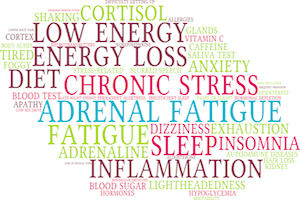
Adrenal Fatigue Symptoms
The theory states that common symptoms of adrenal fatigue include problems falling asleep at night, staying asleep, difficulty waking up, and increased of food cravings, especially for salt and sugar. Even if a good night’s sleep is had, an individual with adrenal fatigue feels tired all the time.
What are the Adrenal Glands?
You have two adrenal glands, each paired with one of your kidneys. They belong to your endocrine system along with your thyroid, pituitary gland, pancreas, ovaries/or testes, and parathyroid glands. These organs produce hormones that regulate growth, sleep, mood, metabolism, and your fertility.
What is Adrenal Insufficiency?
Adrenal fatigue is different from adrenal insufficiency. Also known as Addison’s disease, adrenal insufficiency occurs due to the disruption of your adrenal glands due to nutritional imbalances. This causes them to stop producing aldosterone, the hormone that regulates blood pressure and salt levels in the blood, and also cortisol, the hormone your body uses to counteract stress, but cortisol does a lot more. It helps maintain blood pressure, slows inflammatory response, and also contributes to metabolism.
Autoimmune disorders account for the majority of cases of Addison’s disease http://www.dreddyclinic.com/findinformation/aa/addisonsdisease.php where tuberculosis, fungal infections, and cancer account for the remainder of causes. [1]
The symptoms of adrenal insufficiency are mostly different and much more dramatic than adrenal fatigue. It usually begins with loss of appetite, weight loss, and weakness. Half of the people affected will have nausea, vomiting, and diarrhea. Symptoms also include low blood pressure, dizziness, and darkening of the skin in scars, skin folds, areas like knees, elbows, knuckles, toes, and lips. If left unaddressed, it can be fatal.
Adrenal insufficiency can be treated with hormones to replace the ones not being produced.
How to Keep Your Endocrine System in Balance
If you’re under constant stress and feel chronic fatigue, you can take a few simple steps to keep your endocrine system in balance.
1. Set time aside to rest. While sleep may be difficult to come by, when you take some time to wind down, it helps your body relax.
2. Exercise. It may seem counterintuitive, but exercise decreases stress and reduces cortisol levels. [2]
3. Avoid endocrine disruptors http://www.dreddyclinic.com/forum/viewtopic.php?f=122&t=33420. These chemicals and some foods interfere with your hormones and can overly stress your adrenal glands if exposed in excess.
4. Implement an adrenal fatigue diet https://www.adrenalfatigue.org/adrenal-fatigue-diet. You need a variety of natural, organic foods including healthy proteins, whole grains, and fruits and vegetables for proper adrenal nutrition.
5. Adrenal Fatigue Supplements. Iodine plays a large role in hormone balance http://www.dreddyclinic.com/forum/viewtopic.php?f=28&t=32229. To promote hormone balance naturally, make sure you supplement with vitamin C, vitamin E, B vitamins, calcium and magnesium. For more information on a high quality vitamin supplement, I personally recommend IntraMAX® http://dreddyclinic.com/forum/viewtopic.php?f=21&t=33845.
Hormonal imbalance affects every aspect of your body and life, and the effects create a wide variety of symptoms including feeling fatigued. As stated in this article, hormones regulate many body functions and is imperative to know how to take control of your health. I created a webinar where you can learn all about hormonal imbalance http://www.dreddyclinic.com/forum/viewtopic.php?f=122&t=33420, from causes to symptoms and remedies. I highly recommend taking the time to watch it!
Now, if you do have chronic fatigue and your symptoms are seriously disrupting your life or you’re feeling depressed, you should see your healthcare provider to rule out more serious conditions.
by Dr. Edward Group DC, NP, DACBN, DCBCN, DABFM
References:
1. Pituitary Network Association. Adrenal Insufficiency (Addison’s Disease) http://pituitary.org/knowledge-base/disorders/adrenal-insuffieciency-addison-s-disease.
2. Alghadir AH1, Gabr SA2. Physical activity and environmental influences on adrenal fatigue of Saudi adults: biochemical analysis and questionnaire survey http://www.ncbi.nlm.nih.gov/pubmed/26311923. J Phys Ther Sci. 2015 Jul;27(7):2045-51. doi: 10.1589/jpts.27.2045. Epub 2015 Jul 22.
4 Dangers of Food Dyes
(DrEddyClinic News) Artificial additives pervade our food supply at epic proportions. Manufacturers claim the stuff is added to enhance flavor, appearance, texture, and shelf life. Food dyes, a food additive used to deepen the color of candy, dry mixes, soups, and even bread, have gotten an increasing amount of criticism these last few years.
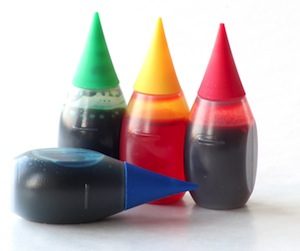
Health authorities in Austria and Norway have even banned the use of artificial food dyes and European health authorities require a warning label on food that contains the synthetic ingredients. In Britain, warn labels caution that children who consume foods containing artificial food colorings are at greater risk for developing hyperactive behavior and ADHD http://dreddyclinic.com/forum/viewtopic.php?f=18&t=32199. Meanwhile, the FDA in the United States has yet to say much about the proven health dangers surrounding these synthetic ingredients. So just how dangerous are artificial food dyes? The next four facts will inform you.
1. Made From Petroleum
Originally made from coal tar, food dyes now come from an unrefined fuel source — petroleum. Consuming petroleum in any amount isn’t the most pleasant thought; however, that’s just what you may be doing if you eat non-organic, processed foods. Many popular sports drinks, sodas, powdered mixes, and energy drinks http://dreddyclinic.com/forum/viewtopic.php?f=11&t=33300 contain petroleum-derived food colorings. [1]
2. Possible Carcinogen
Red 40 and Yellow 5 and 6 contain the chemical benzene, a known carcinogen. The CDC claims that very little is known about the health effects of benzene, despite the mountain of evidence pointing at its cancer-causing potential. [2] While most of the world has banned the use of artificial additives containing this compound, American companies freely use Red 40 and Yellow 5 and 6 in many common processed food products http://www.dreddyclinic.com/forum/viewtopic.php?f=36&t=33723. Processed macaroni and cheese, for example, commonly use Yellow 6 to bring out the food’s bright-yellow hue.

3. Contributes to ADHD Risk
Numerous studies have established a significant link between artificial food dyes and hyperactivity in children http://www.dreddyclinic.com/forum/viewtopic.php?f=39&t=31861. An Australian study examining food dyes’ effects on 200 children found that 75% of parents noticed an improvement in behavior and attention once dyes were eliminated from their child’s diet. [3] Other research has validated this finding, suggesting future studies to determine safe intake levels for these products (if they exist, which I doubt). [4]
4. Estrogen Enhancers
Perhaps “enhance” isn’t the best word because this isn’t a good thing. Sunset yellow (Yellow 6) and tartrazine (Yellow 5) have been shown to behave like estrogen in the human body. [5] Why is this bad? Because high levels of estrogen, regardless of the source, can contribute to breast cancer http://www.dreddyclinic.com/findinformation/cc/breastcancer.php and may decrease male sex drive http://www.dreddyclinic.com/forum/viewtopic.php?f=31&t=33625, among other highly undesirable effects. [6] [7]
Alternatives Exist – Choose Wisely!
The only way to completely avoid artificial food dyes is to consume an unprocessed, whole-food diet http://dreddyclinic.com/forum/viewtopic.php?f=18&t=31926. If you’re in a time crunch and have to purchase a processed food item, make sure it is organic. Organic products are prohibited from using artificial coloring, sweeteners, or flavorings. Although organic processed foods are not the most nutrient-dense food http://dreddyclinic.com/forum/viewtopic.php?f=18&t=33279 on the planet, they are a far better alternative to other options.
Have you eliminated food dyes from your diet? What benefits have you experienced? Leave a comment and share your experience!
by Dr. Edward Group DC, NP, DACBN, DCBCN, DABFM
References:
1. CSPI. Food Dyes: A Rainbow of Risks http://cspinet.org/new/pdf/food-dyes-rainbow-of-risks.pdf. Washington, DC: Center for Science in the Public Interest; 2010.
2. Kobylewski S1, Jacobson MF. Toxicology of food dyes http://www.ncbi.nlm.nih.gov/pubmed/23026007. Int J Occup Environ Health. 2012 Jul-Sep;18(3):220-46. doi: 10.1179/1077352512Z.00000000034.
3. Rowe KS1, Rowe KJ. Synthetic food coloring and behavior: a dose response effect in a double-blind, placebo-controlled, repeated-measures study http://www.ncbi.nlm.nih.gov/pubmed/7965420. J Pediatr. 1994 Nov;125(5 Pt 1):691-8.
4. Stevens LJ1, Kuczek T, Burgess JR, Stochelski MA, Arnold LE, Galland L. Mechanisms of behavioral, atopic, and other reactions to artificial food colors in children http://www.ncbi.nlm.nih.gov/pubmed/23590704. Nutr Rev. 2013 May;71(5):268-81. doi: 10.1111/nure.12023.
5. Axon A1, May FE, Gaughan LE, Williams FM, Blain PG, Wright MC. Tartrazine and sunset yellow are xenoestrogens in a new screening assay to identify modulators of human oestrogen receptor transcriptional activity http://www.ncbi.nlm.nih.gov/pubmed/22562034. Toxicology. 2012 Aug 16;298(1-3):40-51. doi: 10.1016/j.tox.2012.04.014.
6. Russo J, Russo IH. The role of estrogen in the initiation of breast cancer http://www.ncbi.nlm.nih.gov/pubmed/17113977. The Journal of Steroid Biochemistry and Molecular Biology. 2006 December;102(1-5):89-96.
7. Siepmann T, Roofeh J, Kiefer FW, Edelson DG. Hypogonadism and erectile dysfunction associated with soy product consumption http://www.ncbi.nlm.nih.gov/pubmed/21353476. Nutrition. 2011 July-August;27(7-8):859-62. doi: 10.1016/j.nut.2010.10.018.
Vegan Custard Stuffed Pumpkin
(DrEddyClinic News) This vegan custard recipe was inspired by the Cambodian recipe for sangkya, also known as songkya. Traditional sangkya is an eggy custard with a strong coconut flavor. Most recipes call for quite a bit of sugar, so this recipe is a loosely adapted interpretation of the original. It’s much healthier, completely vegan, and is a great alternative to flour-based holiday treats. This seasonal dessert does need to chill for several hours before serving, so plan ahead.
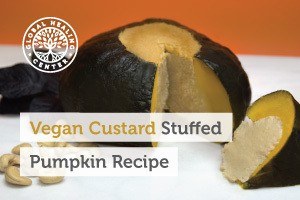
The coconut yogurt and soaked cashew base are held together with coconut, garbanzo, and chia seed flour. The sweetness of the maple syrup is balanced with lemon zest and juice. You can adjust the amount of lemon, or add more coconut flakes if you want a less tart or more coconutty flavor.
Kabocha, or Japanese pumpkin, is the best choice for this recipe. Similar to butternut squash, the kabocha has fewer calories and many people say it tastes better. It’s a great source of beta-carotene, iron, vitamin C http://www.dreddyclinic.com/forum/viewtopic.php?f=21&t=35740, and fiber. You can substitute pie pumpkins if you have trouble finding kabocha. When selecting your kabocha squash, choose a squat, wide shape over a taller, round one. This will give the top of the custard a better chance to brown while baking. You can also skip the pumpkin entirely if you’re just looking for a vegan baked custard recipe. If you choose this route, make sure to bake the custard for only twenty minutes.
One item to note… This recipe makes enough custard to fill a pumpkin with a 25 in. (63 cm) circumference. If you’re using a smaller pumpkin, you may want to halve this recipe. I recommend keeping a small (5”) springform pan ready for any leftover custard. Just bake it along with your pumpkin for twenty minutes and allow to cool.
How Did Pumpkins Get to Japan?
If you thought pumpkin and squash came from the Americas, you are absolutely correct. Portuguese traders and explorers originally brought squash and pumpkins from Brazil to Japan in the 16th century[1] while the Portuguese Empire was expanding into South Asia. The kabocha squash is simply a variety of Cucurbita maxima—the same species that produces the gigantic pumpkins that win ribbons at state fairs. I don’t recommend you try to make this recipe with one of those monsters, though. It could feed an army, but the cooking time would take days! Their smaller Japanese cousins, however, do quite nicely.
In Japan, the squash is called Kuri Kabocha, or “nutty pumpkin”.[2] If you’ve ever tasted kabocha you’ll understand the “nutty” moniker. The texture is fluffy and reminiscent of chestnuts, but the flavor is sweet, like a butternut squash crossed with a sweet potato. Kabocha squash have dark, forest-green skin, a slightly squished or flattened shape, and brilliant orange flesh.[3] You can actually leave your kabocha out as a decoration if you’re going to use them within a few days. Otherwise, store them in a dark, cool area for up to a month.[4]
Vegan Custard Stuffed Pumpkin Recipe
- Pre-prep: soak the cashews in lukewarm water for 2-4 hours
- Prep time: 20 minutes to hollow the pumpkin and prepare the filling
- Bake time: 45 minutes at 400°F (250° C)
- Chill time: 3-4 hours or overnight
- Servings: 10
Equipment
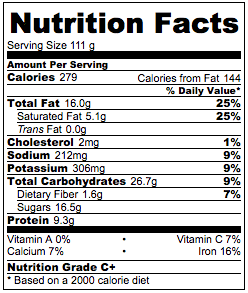
Vegan custard stuffed pumpkin nutrition facts.
- Sharp serrated knife
- Sharp spoon to hollow out pumpkin
- Citrus reamer (optional)
- Food processor or powerful blender
- Silicone baking mat or parchment paper
- Baking sheet
- Small springform pan (optional)
Ingredients
- 1 medium organic kabocha squash (about 25” in circumference)
- 2 cups raw cashews, soaked and strained
- 2 cups organic vanilla coconut vegan yogurt (try our vegan yogurt recipe, just add 1 tbsp maple syrup and 1 tsp vanilla)
- 2 tbsp organic coconut flour
- 1 tbsp organic chia seed flour
- 1 tbsp organic garbanzo bean flour
- ⅔ cup organic maple syrup
- Zest and juice of 2 large organic lemons (about 5 tbsp)
- 3 tsp pure, organic vanilla extract
- ½ cup organic coconut flakes, plus extra (optional)
- 1 tsp Himalayan crystal salt
Instructions
1. Start by preparing the custard. Drain excess water from the soaked cashews.
2. Add cashews, yogurt, coconut flour, chia seed flour, garbanzo bean flour, vanilla extract, and Himalayan crystal salt to the food processor and pulse until smooth, about 2 minutes.
3. Add half the maple syrup and lemon juice and pulse for 15 seconds to combine. Taste custard to determine how much of the remaining maple syrup, lemon juice, and coconut flakes to add. Continue pulsing to mix ingredients. Once the taste suits your preference, allow the custard to remain in the food processor while you carve the squash.
4. Preheat oven to 400°F.
5. Use a serrated knife to cut the crown off the squash. Start a cut a couple inches from the woody stem of the squash. Continue to cut in a circle around the stem. Pull the crown off the squash and set aside.
6. With a sharp spoon, thoroughly remove the seeds and sinew from the inside the pumpkin and discard.
7. Using a spatula, slowly pour the custard into the pumpkin. Do not overfill. Leave enough room to replace the crown. The custard will rise slightly as it cooks and it will need this space to expand. You can either discard the crown or bake it alongside the custard.
8. Add any remaining custard to the springform pan and smooth flat with a spatula.
9. Line a cookie sheet with a silicone baking mat or parchment paper. Place the filled squash, crown, and springform pan on the cookie sheet and place in the oven. If baking the crown, set it next to the squash for baking. Do not put it back on top yet.
10. After twenty minutes, remove the springform pan and place on the counter to cool. You can eat this mini custard while you’re waiting for the main attraction to chill in the fridge.
11. After the squash has been cooking for 40 minutes, check its status. Using the tip of a small knife or fork, poke a small hole in the squash. If it easily cuts into the flesh, congrats! It’s done! If the squash isn’t soft enough, bake at 400°F for another 15 minutes.
12. Let the squash cool on the counter for about ten minutes, then transfer to a plate or large glass bowl to chill in the fridge. If you baked the crown you can put it back on the squash. Chill the custard for at least 3 hours before serving.
13. Use a sharp serrated knife to cut thin slices. Enjoy!
The Difference Between Squash and Pumpkin
Because their genetic history is intertwined, squash, pumpkin, and gourd are often used interchangeably.[5] As a general rule, you carve pumpkins, cook squash, and decorate with gourds.[6] If you let that sink in, you might wonder how it is that we have so many pumpkin-imbued treats every fall. Well, the truth is, our traditional “pumpkin” pies and other tasty dishes are actually made with squash.[7] Pumpkin ice cream, pumpkin lattes, pumpkin cookies, even canned pumpkin actually contain squash.
Don’t despair, it’s just a quirk of taxonomy. Autumnal pumpkin delicacies are usually made using winter squash that resembles carving pumpkins, they’re just not officially classified as pumpkins. Proper pumpkins aren’t eaten because they’re watery, stringy, and don’t taste that good. Winter squash is smaller, softer, and sweeter than its pumpkin cousin. If you feel lost and confused, don’t worry—even the FDA has trouble deciding whether or not you’re eating a pumpkin or a squash.[8]
What pumpkin (or squash) treat do you look forward to every autumn? Leave a comment and let us know!
by Dr. Edward Group DC, NP, DACBN, DCBCN, DABFM
References
1. Center, UMass. Kabocha https://worldcrops.org/crops/kabocha. 2016. Web. 17 Oct. 2016.
2. Morgan, Wendy, and David Midmore. Kabocha and Japanese Pumpkin in Australia A Report for the Rural Industries Research and Development Corporation https://rirdc.infoservices.com.au/downloads/02-167.pdf. 2005. Web. 17 Oct. 2016.
3. Gallary, Christine. Why You Should Be Eating Kabocha squash, Pumpkin’s Sweeter Cousin — ingredient intelligence http://www.thekitchn.com/kabocha-squash-pumpkins-sweeter-cousin-ingredient-intelligence-57871. The Kitchn, 22 Oct. 2014. Web. 17 Oct. 2016.
4. “Kabocha squash: Nutrition . Selection . Storage – fruits & Veggies more matters.” Fruits & Veggies More Matters http://www.fruitsandveggiesmorematters.org/kabocha-squash-nutrition-selection-storage, 2008. Web. 17 Oct. 2016.
5. Ferriol, María, and Belén Picó. “Pumpkin and Winter Squash http://link.springer.com/chapter/10.1007/978-0-387-30443-4_10.” Handbook of Plant Breeding. N.p.: Springer Science + Business Media, n.d. 317–349. Web.
6. “Pumpkin.” http://aggie-horticulture.tamu.edu/archives/parsons/vegetables/pumpkin.html Texas AgriLife Extension. Aggie horticulture. n.d. Web. 17 Oct. 2016.
7. Crist, Emma. I Just Found Out Canned Pumpkin Isn’t Pumpkin At All, And My Whole Life Is Basically a Lie http://www.foodandwine.com/news/i-just-found-out-canned-pumpkin-isnt-pumpkin-all-and-my-whole-life-basically-lie. Food & Wine, 23 Sept. 2016. Web. 17 Oct. 2016.
8. Sevier, Joe. Canned pumpkin: It’s not what you think http://www.epicurious.com/ingredients/what-is-in-canned-pumpkin-article. Epicurious, 9 Sept. 2016. Web. 17 Oct. 2016.





